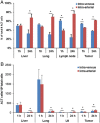Intra-arterial Versus Intravenous Adoptive Cell Therapy in a Mouse Tumor Model
- PMID: 29985207
- PMCID: PMC6092084
- DOI: 10.1097/CJI.0000000000000235
Intra-arterial Versus Intravenous Adoptive Cell Therapy in a Mouse Tumor Model
Abstract
Adoptive cell transfer therapy for cancer has existed for decades and is experiencing a resurgence in popularity that has been facilitated by improved methods of production, techniques for genetic modification, and host preconditioning. The trafficking of adoptively transferred lymphocytes and infiltration into the tumor microenvironment is sine qua non for successful tumor eradication; however, the paradox of extremely poor trafficking of lymphocytes into the tumor microenvironment raises the issue of how best to deliver these cells to optimize entry into tumor tissue. We examined the route of administration as a potential modifier of both trafficking and antitumor efficacy. Femoral artery cannulation and tail vein injection for the intra-arterial (IA) and IV delivery, respectively, were utilized in the B16-OVA/OT-I mouse model system. Both IV and IA infusions showed decreased tumor growth and prolonged survival. However, although significantly increased T-cell tumor infiltration was observed in IA mice, tumor growth and survival were not improved as compared with IV mice. These studies suggest that IA administration produces increased early lymphocyte trafficking, but a discernable survival benefit was not seen in the murine model examined.
Figures







Similar articles
-
Anti-Tumor Effects after Adoptive Transfer of IL-12 Transposon-Modified Murine Splenocytes in the OT-I-Melanoma Mouse Model.PLoS One. 2015 Oct 16;10(10):e0140744. doi: 10.1371/journal.pone.0140744. eCollection 2015. PLoS One. 2015. PMID: 26473608 Free PMC article.
-
Accumulation in tumor tissue of adoptively transferred T cells: A comparison between intravenous and intraperitoneal injection.J Immunother. 2006 May-Jun;29(3):241-9. doi: 10.1097/01.cji.0000203078.97493.c3. J Immunother. 2006. PMID: 16699367
-
Adenoviral Delivery of Tumor Necrosis Factor-α and Interleukin-2 Enables Successful Adoptive Cell Therapy of Immunosuppressive Melanoma.Mol Ther. 2016 Aug;24(8):1435-43. doi: 10.1038/mt.2016.137. Epub 2016 Jun 30. Mol Ther. 2016. PMID: 27357626 Free PMC article.
-
Predictors of tumor-infiltrating lymphocyte efficacy in melanoma.Immunotherapy. 2016;8(1):35-43. doi: 10.2217/imt.15.99. Epub 2015 Dec 10. Immunotherapy. 2016. PMID: 26653685 Review.
-
Trafficking of T cells into tumors.Cancer Res. 2014 Dec 15;74(24):7168-74. doi: 10.1158/0008-5472.CAN-14-2458. Epub 2014 Dec 4. Cancer Res. 2014. PMID: 25477332 Review.
Cited by
-
Systemic Delivery of Oncolytic Adenovirus to Tumors Using Tumor-Infiltrating Lymphocytes as Carriers.Cells. 2021 Apr 22;10(5):978. doi: 10.3390/cells10050978. Cells. 2021. PMID: 33922052 Free PMC article.
-
Pre-conditioning modifies the TME to enhance solid tumor CAR T cell efficacy and endogenous protective immunity.Mol Ther. 2021 Jul 7;29(7):2335-2349. doi: 10.1016/j.ymthe.2021.02.024. Epub 2021 Feb 27. Mol Ther. 2021. PMID: 33647456 Free PMC article.
-
Delivery of a model lipophilic membrane cargo to bone marrow via cell-derived microparticles.J Control Release. 2020 Oct 10;326:324-334. doi: 10.1016/j.jconrel.2020.07.019. Epub 2020 Jul 16. J Control Release. 2020. PMID: 32682903 Free PMC article.
-
Human intravital microscopy in the study of sarcomas: an early trial of feasibility.Front Oncol. 2023 Apr 12;13:1151255. doi: 10.3389/fonc.2023.1151255. eCollection 2023. Front Oncol. 2023. PMID: 37124504 Free PMC article.
-
Combined targeting of soluble latent TGF-ß and a solid tumor-associated antigen with adapter CAR T cells.Oncoimmunology. 2022 Nov 11;11(1):2140534. doi: 10.1080/2162402X.2022.2140534. eCollection 2022. Oncoimmunology. 2022. PMID: 36387056 Free PMC article.
References
-
- Rosenberg SA, Packard BS, Aebersold PM, et al. Use of tumor-infiltrating lymphocytes and interleukin-2 in the immunotherapy of patients with metastatic melanoma. A preliminary report. N Engl J Med. 1988;319:1676–1680. - PubMed
Publication types
MeSH terms
Grants and funding
LinkOut - more resources
Full Text Sources
Other Literature Sources
Medical
Molecular Biology Databases

